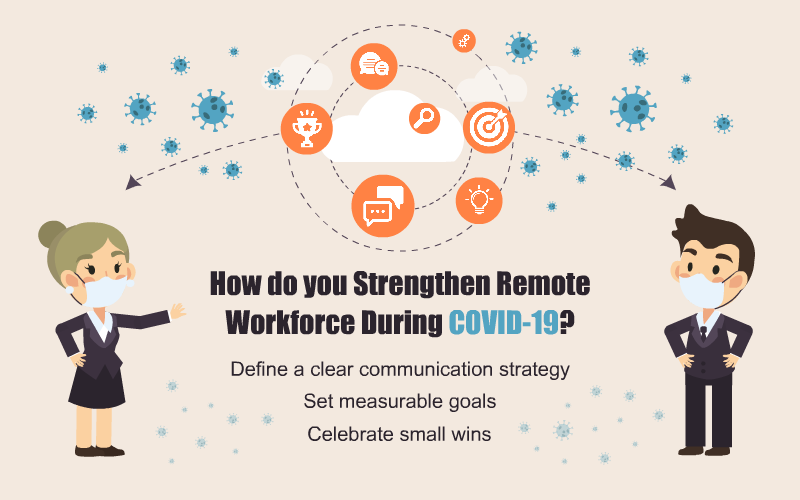Strengthening an ‘Accidental’ Remote Workforce During COVID-19 Times

The COVID-19 pandemic has forced millions of people to start working remotely. Organizations that required employees to come in to work every day, suddenly found themselves thrown off balance. On top of everything else, they are now faced with the task of dealing with a workforce that has ‘accidentally’ become remote.
According to a survey from Gartner, 88% of organizations have required employees to work from home, irrespective of whether or not they showed symptoms related to the coronavirus.
Tips to Strengthen your Remote Workforce in the Times of Coronavirus
- Define a clear communication strategy
- Set measurable goals
- Focus on the big picture
- Celebrate the small wins
- Provide opportunities for virtual training
Working remotely, once considered a perk, has become a lifeline for organizations who want to stay in business in these challenging times. Yes, working remotely has become the new norm in organizations across the globe. But with that come some unique challenges – isolation, bandwidth, distractions, lack of clarity on work-related tasks, and uncertainty about what the future holds.
The COVID-19 pandemic has put unprecedented pressure on most IT teams in organizations as they figure out the right technology to enable their remote workforce to function and be productive. And that brings us to an urgent question that needs to be answered. Is your organization able to offer the right kind of support to this accidentally remote workforce?
Jack Gold, founder of J. Gold Associates, summed it up very well when he tweeted, “Organizations are concentrating on finding a collaboration tool when the bigger issue is training people how to work with others in remote work situations”. So, how do we consciously work on strengthening our remote workforce to maintain productivity and business results? Take a look at these tips.
Discover techniques to train your workforce in the times of COVID-19.
Suggestions to Strengthen a Suddenly Remote Workforce
1. Define a Clear Communication Strategy
‘Communication’ has always been key for a successful workplace and will be, even more so, for a remote workforce as well. But with the current COVID-19 pandemic, the mantra is to COMMUNICATE…COMMUNICATE…COMMUNICATE! And all this, while maintaining social distancing!

When employees come in to work, it’s very easy to spot anxiety or burnout by simply looking at their faces. But that’s not possible in this ‘remote’ scenario. So, communicate frequently and regularly with your team to ‘feel their pulse’ – not only to find out how they are coping up with working remotely but also to tell them what’s going on with the company.
Plucked from the camaraderie of the workplace, your employees suddenly find themselves working at home, alone. This isolation can cause disengagement that needs to be quickly tackled. Tools such as Teams, Zoom, and Hangouts can help you stay connected with your team. Use them to communicate on day-to-day tasks and hold meetings (virtually), just as you would if you were in office.
| Did you know that the ongoing coronavirus pandemic has led to a surge in the usage of Microsoft Teams?
As of March 11th, 2020, the software giant has 32 million users, but within a week the number had shot up by a whopping 12 million, taking the userbase to 44 million! |
2. Set Measurable Goals
COVID-19 has set off a change management reaction, but unlike a planned change management strategy, this one gives very little time – to set processes to proactively overcome the disruption.
It’s evident that only those who push themselves to change will survive. Organizations with traditional work and training practices are faced with the task of transforming themselves overnight just to stay in business. Many organizations have needed to switch to online methods – right from training their newly remote workforce to selling their products to potential customers.
With such a lot of change happening, you might have to take a long hard look at your organizational goals – if some of them need to be reinvented or shifted, or even discarded if that makes better business sense in these challenging times. Apart from business continuity, you need to also focus on training-continuity. After all, training is a very effective method to keep employees aligned to your organizational goals.
It would be a good idea to break up long-term goals into short-term ones. That can take the stress out of your remote workforce and help them prioritize their work.
3. Focus on the Big Picture
Trying to get things done while maintaining normal business operations in the face of a crisis, is a challenging task indeed. Not to forget, the additional pressure to find new channels to reach out to customers and prospects and trying different operational tactics, even when it feels like shooting in the dark. In short, organizations need to try anything and everything to keep the business afloat in the face of a shrinking world economy.
At the risk of sounding clichéd, I would say, with every crisis there comes opportunity. Leaders must step back and try to make sense of the current situation. Step away if you must, from the urgent but small, everyday problems that a business faces, but do not lose focus of the big picture.
Encourage your team to see the big picture too. Let them know the ‘why’ behind every ‘what’ they need to do. Empower them to make their own decisions and implement new ideas, as engaged employees can steer your organization out of these challenging times.
4. Celebrate the Small Wins
Often small mistakes make us feel bad but small wins don’t give us great highs! They can get overlooked easily, especially when employees are working remotely. And for an accidentally remote workforce, this can get stressful. Your team is going to be more productive when they’re intrinsically motivated and feel appreciated.
Celebrating the small accomplishments of your team is a great way to motivate your remote workforce, giving them some much needed highs in this time of increasing lows. Perhaps it’s time for a virtual party or give your team a day off from work!
5. Provide Opportunities for Virtual Training
Unprecedented times like the present global coronavirus pandemic are when learning and development programs take a backseat. Organizations with more of face-to-face training are going to find it more difficult to get their training initiatives back on track as against many others with online training programs already in place.
Right from the small school in your neighborhood to the most prestigious universities in the world, everyone’s experimenting with online training. COVID-19 is not the time to press the pause button on learning and development programs for your employees. Switch to technology-enabled learning that can be continued outside the classroom. Use virtual classrooms, webcasts, audio- and videoconferencing, rapid eLearning, or any other form of digital learning to let your remote workforce continue to learn… and be productive!
It’s a Wrap
Working remotely (even when that is ‘from home’) is neither easy nor comfortable. It is completely different from working in a traditional office setup. The conversations and debates over lunch or friendly chats at the water fountain will be sorely missed by this accidentally remote workforce, until further notice. It’s up to the leaders and managers to steer their remote workers through this difficult time and keep them engaged and connected.
More information on ideas to set up learning for your remote workforce will be in our next blog. Stay tuned and subscribe to our blogs to get information delivered to your inbox.
Click here to subscribe to our blogs.
If you’ve already decided to switch from classroom to virtual training, download our free eBook ‘Generating Motivation and Excitement in the Virtual Classroom’ for useful tips and solutions to combat challenges you might face while moving your training to the virtual space.





